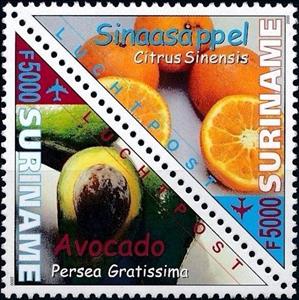Se-tenant: Avacado & Orange (Suriname 2000)
Avacado & Orange (Suriname 2000)
29 February (Suriname ) within release Fruits goes into circulation Se-tenant Avacado & Orange face value 10,000 Surinamese guilder
| Se-tenant Avacado & Orange in catalogues | |
|---|---|
| Michel: | Mi: SR 1732-1733 |
| Stamp Number: | Sn: SR 1219 |
Se-tenant is square format.
Also in the issue Fruits:
- Stamp - Pineapple face value 250;
- Stamp - Orange face value 5,000;
- Stamp - Grape fruit face value 200;
- Stamp - Pomegranate face value 250;
- Stamp - Banana face value 200;
- Stamp - Wood apple face value 175;
- Stamp - Passion fruit face value 325;
- Stamp - Coconut face value 325;
- Stamp - Avacado face value 5,000;
- Stamp - Mango face value 175;
- Stamp - Watermelon face value 50;
- Se-tenant - Passion fruit & Coconut face value 650;
- Se-tenant - Papaya & Watermelon face value 100;
- Se-tenant - Grape fruit & Banana face value 400;
- Se-tenant - Wood apple & Mango face value 350;
- Se-tenant - Pineapple & Pomegranate face value 500;
- Stamp - Papaya face value 50;
- Se-tenant - Avacado & Orange face value 10,000;
Se-tenant Avacado & Orange it reflects the thematic directions:
In botany, a fruit is the seed-bearing structure in flowering plants (also known as angiosperms) formed from the ovary after flowering. Fruits are the means by which angiosperms disseminate seeds. Edible fruits, in particular, have propagated with the movements of humans and animals in a symbiotic relationship as a means for seed dispersal and nutrition; in fact, humans and many animals have become dependent on fruits as a source of food. Accordingly, fruits account for a substantial fraction of the world's agricultural output, and some (such as the apple and the pomegranate) have acquired extensive cultural and symbolic meanings. In common language usage, "fruit" normally means the fleshy seed-associated structures of a plant that are sweet or sour, and edible in the raw state, such as apples, bananas, grapes, lemons, oranges, and strawberries. On the other hand, in botanical usage, "fruit" includes many structures that are not commonly called "fruits", such as bean pods, corn kernels, tomatoes, and wheat grains. The section of a fungus that produces spores is also called a fruiting body.
Flora is the plant life occurring in a particular region or time, generally the naturally occurring or indigenous—native plant life. The corresponding term for animal life is fauna. Flora, fauna and other forms of life such as fungi are collectively referred to as biota. Sometimes bacteria and fungi are also referred to as flora, as in the terms gut flora or skin flora.
The Kionga Triangle (German: Kionga-Dreieck, Portuguese: Triângulo de Quionga) was a small region of German East Africa situated at the mouth of the Ruvuma River. The Ruvuma served as the border between the German colony and Portuguese Mozambique, and the Kionga Triangle was the only section of German East Africa south of the river. Its principal settlement was Kionga (now Quionga ) which had a population of 4,000 in 1910. It became a German possession in 1894 but came under Portuguese control in April 1916 during World War I. The post-war Treaty of Versailles reaffirmed that the river was the border between Tanganyika, then under British control, and Portuguese Mozambique. The triangle was the only territory that the treaty awarded to Portugal.


